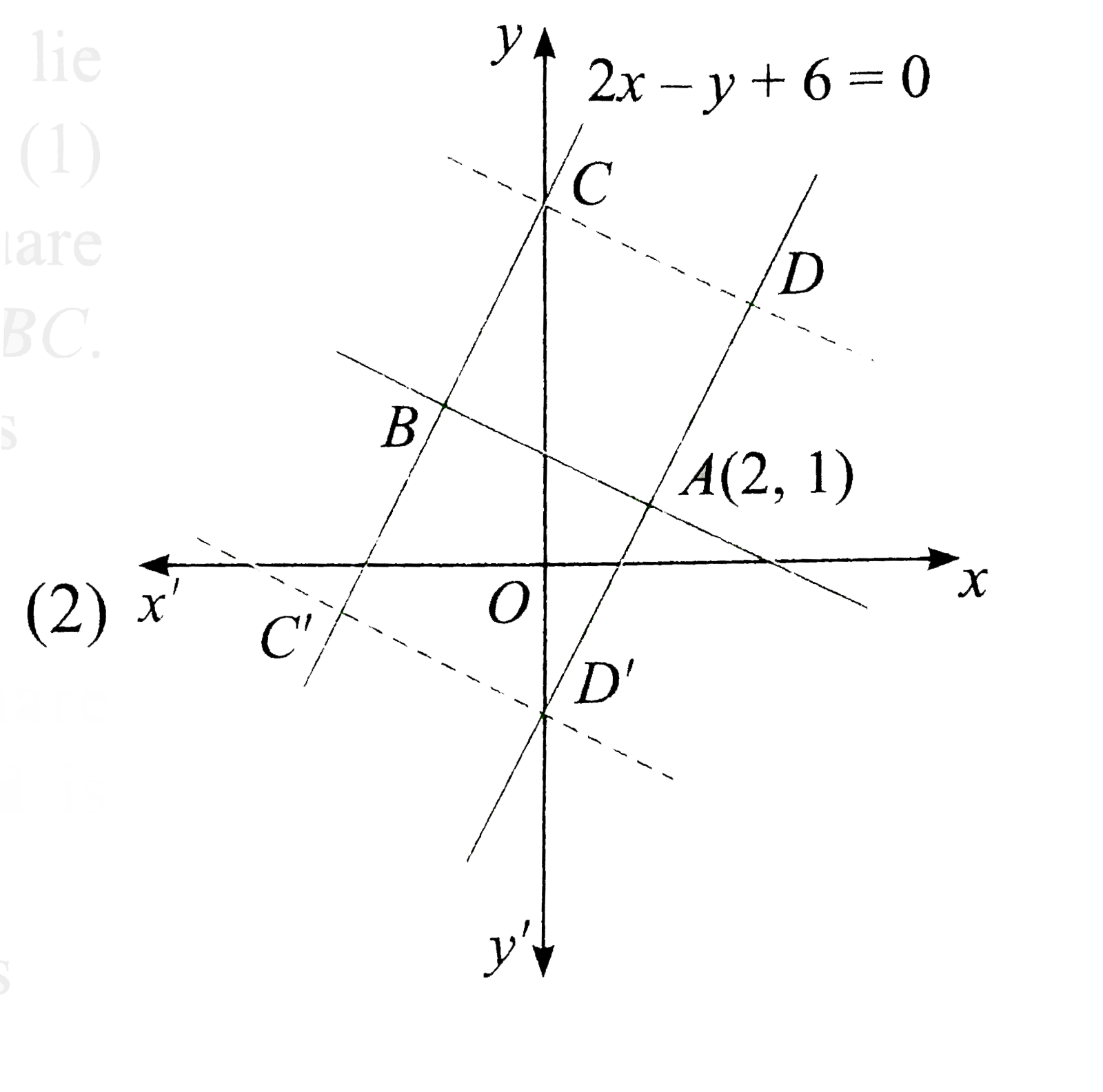If one side of the square is 2x−y+6=0, then one of the vertices is (2,1) . Find the other sides of the square.Solution in Bengali

Vertex A(2,1) does not lie on the line BC=2x-y+6=0 (1)
Hence, one of the side of the square passing through A is parallel to BC.
Therefore, the equation of AD is
y-1=2(x-2)
or2x−y−3=0 (2)
Another side AB of the square is passing through (2,1) and is perpendicular to BC.
Therefore, the equation of AB is
y−1=−12(x−2)
orx+2y−4=0 (3)
The third side is parallel to AB, which has equation
x+2y+c=0 (4)
Now, the distance between the lines BC and AD is 9/√5.
Therefore, the distance between the lines (3) and (4) is
|C+4|√5=9√5
∴c=5or−13 Therefore, the equation of the third side is
x+2y+5=0 (≡C'D')
or x+2y−13=0(≡CD)
Topper's Solved these Questions
- BOOK - CENGAGE PUBLICATIONCHAPTER - STRAIGHT LINESEXERCISE - EXAMPLE12videos
STRAIGHT LINES
- BOOK - CENGAGE PUBLICATIONCHAPTER - STRAIGHT LINESEXERCISE - CONCEPT APPLICATION EXERCISE 2.123videos
STRAIGHT LINES
- BOOK - CENGAGE PUBLICATIONCHAPTER - STRAIGHT LINEEXERCISE - Multiple Correct Answers Type8videos
STRAIGHT LINE
- BOOK - CENGAGE PUBLICATIONCHAPTER - THEORY OF EQUATIONSEXERCISE - JEE ADVANCED (Numerical Value Type )1videos
THEORY OF EQUATIONS
Similar Questions
Show that the lines 4x+y−9=0,x−2y+3=0,5x−y−6=0 make equal intercepts on any line of slope 2.
03:19View SolutionFind the equation of the right bisector of the line segment joining the points (3,4) and (-1,2).
07:14View SolutionThe point P(α,α+1) will lie inside the triangle whose vertices are A(0,3),B(−2,0) and C(6,1) if
07:05View SolutionThe number of distinct real roots of x4−4x3+12x2+x−1=0is_____.
05:34View SolutionThe center of a square is at the origin and its one vertex is A(2,1). Find the coordinates of the other vertices of the square.
07:53View SolutionIf one side of the square is 2x−y+6=0, then one of the vertices is (2,1) . Find the other sides of the square.
03:57View SolutionEach side of a square is of length 6 units and the centre of the square Is (-1,2). One of its diagonals is parallel to x+y=0. Find the co- ordinates of the vertices of the square.
02:43View SolutionOne side of square ABCD is on the line y=2x−17 and other two vertices are on parabola y=x2, if the minimum area of square is A then find A16.
06:40View Solutionकिसी वर्ग की एक भुजा के सिरे (0,0) और (a,0) हैं, तो अन्य शीर्षों के निर्देशांक निकालिए ।
View Solutionएक त्रिभुज में, यदि एक भुजा का वर्ग अन्य दो भुजाओं के वर्गा के योगफल के बराबर होता है, तो सिद्ध कीजिए कि पहली भुजा के सामने का कोण समकोण होता है।
03:23View Solutionवर्ग ABCD का एक शीर्ष A मूलबिंदु है । यदि वर्ग की भुजाएँ AB और AD क्रमश : x-अक्ष और y-अक्ष हों और वर्ग की भुजा a हो , तो वर्ग के शीर्षों के निर्देशांक बताइए ।
09:38View SolutionIf in a triangle, square of one side is equal to the sum of squares of the other two sides, then the angle opposite the first side is :
08:51View SolutionIn a traingle, if square of one side is equal to the sum of the squares of other two sides, then the angle opposite the fitst side is :
03:41View SolutionThe center of a square is at the origin and its one vertex is A(2,1) . Find the coordinates of the other vertices of the square.
03:35View SolutionIf one side of the square is 2x−y+6=0, then one of the vertices is (2,1) . Find the other sides of the square.
05:08View SolutionIf one side of the square is 2x−y+6=0, then one of the vertices is (2,1) . Find the other sides of the square.
05:19View Solution

